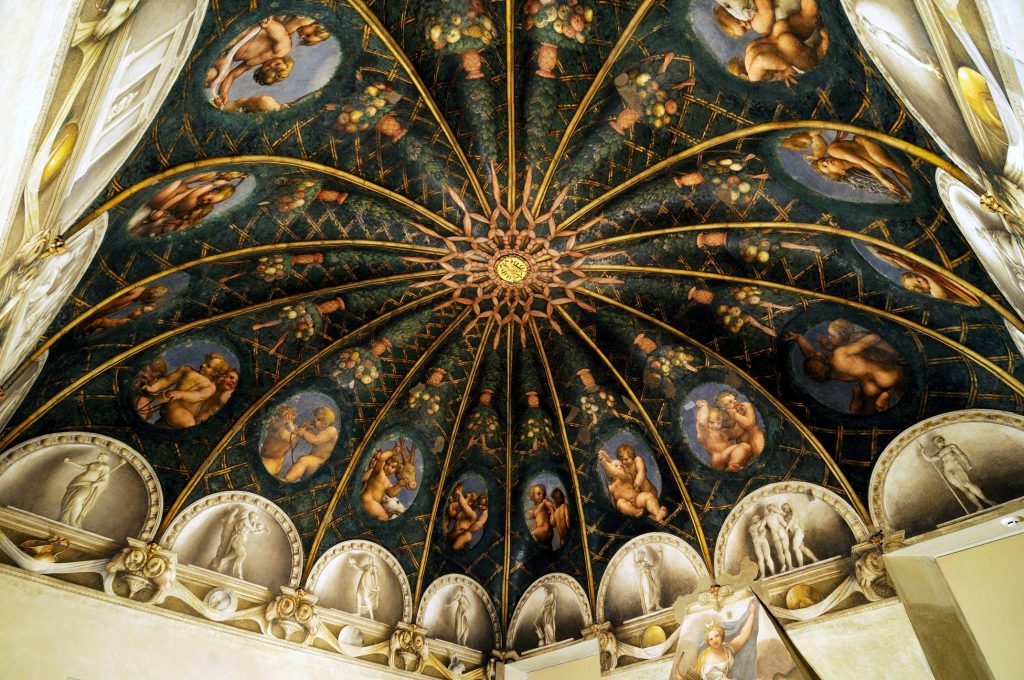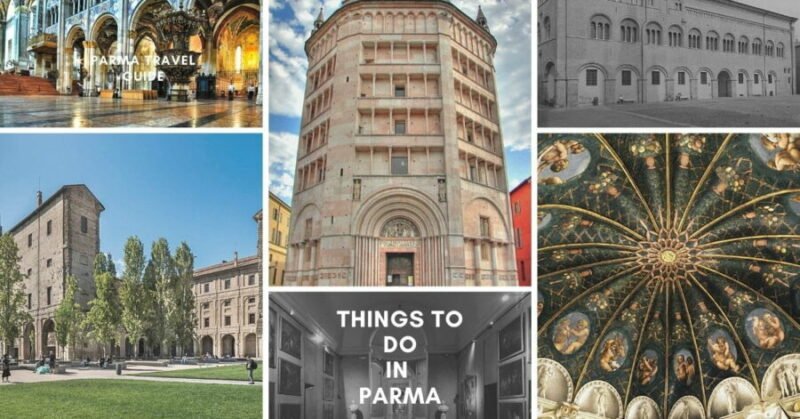14 Best Things to Do in Parma, Italy
Parma is a city full of monuments, beautiful churches, interesting museums, and cuisine you must try at least once. Parma is located in the northwestern area of Emilia Romagna, in a central position between the Tuscan-Emilian Apennines and the Po Valley.
This position makes it an easily accessible tourist destination thanks to the presence of highways and the Giuseppe Verdi airport, located a few kilometers from the city.
The city of Parma has more than 300 archaeological and architectural cultural assets. This immense cultural heritage and a particular geographical position make the city a beautiful and exciting tourist destination.
Parma Cathedral

Start your visit from Piazza del Duomo, one of the most beautiful squares in Italy. The Cathedral, the Baptistery, and the Bishop’s Palace create a unique setting and tell the millennial history of this city. The Cathedral, a symbol of Parma, is considered the finest example of a Romanesque-style church.
Built during the 11th and 12th centuries in 1526, Correggio created an extraordinary cycle of frescoes in the large dome, inspired by the Assumption of the Virgin theme.
Baptistery of Parma

The other important monument in the square is the Baptistery, built with an octagonal plan during the 12th and 13th centuries. The exterior of the Baptistery is in pink marble from Verona, decorated with arches, columns, friezes and bas-reliefs that make the huge structure very elegant. The whole exterior is a story in pictures, with real and fantastic animals; we also find depicted the life of Jesus and Mary, John the Baptist, death and resurrection, as well as the decorations of the internal dome tell of Jerusalem after the end of the world, with the apostles and evangelists.
Bishop’s Palace

The last protagonist of the square is the Bishop’s Palace, now the bishop’s seat and the Diocesan Museum. Dating back to the 11th century, the building has been renovated several times but medieval and Renaissance elements can still be admired. A wing of the building now houses the Diocesan Museum where you can admire works of art from the Cathedral and the Baptistery. In addition, you can see precious Roman mosaics dating back to the fifth century and even more ancient finds that emerged during the excavation and restoration works.
San Giovanni Evangelista

The Monastery of San Giovanni Evangelista, behind the Cathedral, is a monastic complex formed by the church, the convent and the Spezieria (ancient pharmacy) of San Giovanni. The church was largely frescoed by Correggio who reached the apex in the decoration of the dome: with an extraordinary perspective game, the artist creates an imaginary open sky on whose clouds the apostles rest with the figure of Christ in the centre. From the outside, you can access the Monastery with its four cloisters and, above all, the wonderful Spezieria (or pharmacy). Active for monks only since 1201, it represents a true path in the history of medicine. In the first room, called “del Fuoco”, you can still see the ancient counters for the sale and the scales for weighing the ingredients stored in the ceramic and wooden vessels. In the second room (“dei Mortai”), herbs and minerals were prepared. The third room (“delle Sirene”) contains precious medical publications. In the fourth room (del Pozzo or degli Alambicchi), there was the real laboratory and access to the well with water and the cellar where the ingredients were stored.
Sanctuary of Santa Maria della Steccata

The Basilica of Santa Maria della Steccata, built in the late 1300s, has a dome by Antonio da Sangallo the Younger and, inside, frescoes by Parmigianino. Since 1718 the seat of the Constantinian Order of St. George, it also houses a treasure of art and history – the Constantinian Museum della Steccata – with sepulchral chapels of the ducal family, wooden statues and sacred furnishings.
Palazzo della Pilotta

Continuing along our itinerary we arrive at Piazzale della Pace. Here is the Pilotta complex, built for the Farnese dukes. Palazzo della Pilotta is a monumental complex whose construction was begun in 1583 by Ottavio Farnese who simply wanted to make it an appendix to the nearby Ducal Palace. Today the Palace houses the National Archaeological Museum, the Farnese Theater, the Palatine Library, the National Gallery and the Bodonian Museum (which can be viewed with a single cumulative ticket).
The palace was built between the 16th and 17th centuries and represented the power of the Farnese family, as it still testifies today. Several neoclassical buildings overlook the square, among which the Palazzo di Riserva, built during the seventeenth century, inside which is the Farnese Theater, built entirely of wood between 1616 and 1618 at the behest of Duke Ranuccio I Farnese to celebrate the stop in Parma of Cosimo II de Medici. For the time in which it was built, the theater is an example of creativity and technique: the stage was mobile, the characters could be lowered from the other and there was an ingenious system for the scenic flooding of the auditorium. Decayed for many centuries, in 1944 a bomb destroyed most of it. Recovered starting in the 1950s, it was rebuilt according to the original design.
Inside the complex there are, in addition to the Farnese Theater, the National Archaeological Museum of Parma, the Palatine Library, the Bodonian Museum and the National Gallery of Parma, one of the most beautiful art galleries in Italy. The outdoor courtyard is also home to outdoor shows and concerts every year.
Parma National Gallery

The National Gallery of Parma houses the collection of works of art of the Farnese family, consisting of the paintings purchased in Tuscany from 1734 onwards, those returned to their homeland after the French looting, and, above all, those acquired by Maria Luigia of Austria, Duchess of Parma and Piacenza from 1816 to 1847. The chronological itinerary allows you to discover masterpieces from the Middle Ages onwards by Beato Angelico, Correggio, Parmigianino, Leonardo da Vinci, Sebastiano del Piombo, Giulio Romano, Dosso Dossi, Carracci, Guercino, El Greco, Van Dyck, Bronzino, Tintoretto, Canaletto, Bellotto and Tiepolo, just to name a few.
Camera di San Paolo

The Benedictine Monastery of San Paolo contains an Italian Renaissance masterpiece unknown to most people. This is the Camera di San Paolo, or Camera della Badessa (The Room of the abbess – the abbess was Giovanna da Piacenza), frescoed by Correggio in 1519. The extraordinary nature of Correggio’s fresco lies in the illusionistic effect: the room has an almost cubic shape with a late Gothic structure, completely hidden by the decorations. A pergola of foliage and intertwined wicker in which mythological figures move. A garden is hidden within the convent walls, with an entrance directly from the street. At the edge of the garden of the monastery is the cell of St. Catherine, a small chapel with frescoes on the life of St. Catherine of Alexandria, also by Araldi.
San Francesco del Prato, Parma

The church of S. Francesco del Prato, in S. Francesco square, has recently returned to its original splendor. Transformed into a prison by Napoleon in 1810 and used as such until 1992, it was the protagonist of an impressive restoration: the bars were eliminated and other internal interventions restored the original architecture of this Gothic jewel, on whose façade stands a rose window of 1461.
Teatro Regio, Parma

Parma is the city of theater and music, where the notes of Giuseppe Verdi resound. The Teatro Regio (Royal Theater) of Parma is one of the most prestigious theaters in Italy.
Built-in the early nineteenth century by the will of the Duchess Maria Luigia, the Parma opera house has a neoclassical facade and elliptical stalls with white and gold decorations.
Opera, dance, concerts and recitals are held here, first of all the events of the well-known Verdi Festival (every year in October, the month of the great composer’s birth).
The Teatro Regio, which has always been a temple of music in Italy and in the world, can be visited with a guide who explains its history in a 30-minute journey through the Foyer, the stalls and the Ridotto room.
Birthplace of Arturo Toscanini Museum

Also worth mentioning is the Arturo Toscanini House Museum, dedicated to the life and works of the great concert conductor of Parma.
The house is now an interesting museum showcasing period furniture and relics, objects and opera costumes, and evocative spaces such as the Piano Room and the room where 1867 Toscanini was born.
Then there is also the Giordano Ferrari Museum, which exhibits the puppets and marionettes of the very rich internal collection in rotation.
Parco Ducale

Continuing on Viale Giovanni Mariotti, you reach the Giuseppe Verdi bridge, which allows you to cross the Parma stream and reach the Ducal Park. This vast Italian garden houses the palace of the same name that belonged to Duke Ottavio Farnese.
An ideal place for a stroll through the white gravel avenues and to relive the elegance and aristocratic splendor of the eighteenth century among statues and centuries-old trees, this historic park is commonly called “the garden” and is a huge green area, a real green lung for citizens and tourists. In the park there are two important buildings: the Palazzetto Eucherio Sanvitale built in Renaissance style and the Palazzo del Giardino built in the 16th century to be the seat of the ducal court before it was moved to Palazzo della Pilotta.
Parma Foods
As for the cuisine, Parma is synonymous with raw ham, stuffed pasta, and Parmigiano Reggiano cheese. Some of Parma’s famous first courses are born from the combination of egg pasta, cheeses, ham, other types of meat, and Parmesan cheese.
Anolini, tortellini, tortelli to which are added tagliatelle and risotto. The beef stew, boiled meats, tripe, and eggplant parmigiana stand out among the second courses. Try the “rosa di Parma,” roast beef with Parma ham, flaked Parmigiano Reggiano, and Lambrusco wine.
Read also: Where to eat in Parma?
To taste Parmigiano Reggiano, the ideal is to book a guided tour of the dairy to discover the processing stages and savor pieces of different ages.
Outside of Parma
The beauties of the area around Parma also extend outside the historic city center: the surroundings of the city are rich in evidence of the times when Parma was the capital of the Duchy of Parma and Piacenza.
Among the numerous castles of the Duchy, the Reggia di Colorno, known as the “Emilian Versailles”, is absolutely worth a visit; Torrechiara Castle (20 km from the city), in a panoramic position on a hill, among the best preserved in Italy, and Rocca Sanvitale, in Fontanellato (less than 20 km from Parma), with frescoes by Parmigianino, still entirely surrounded by a moat, to keep its medieval beauty intact.







